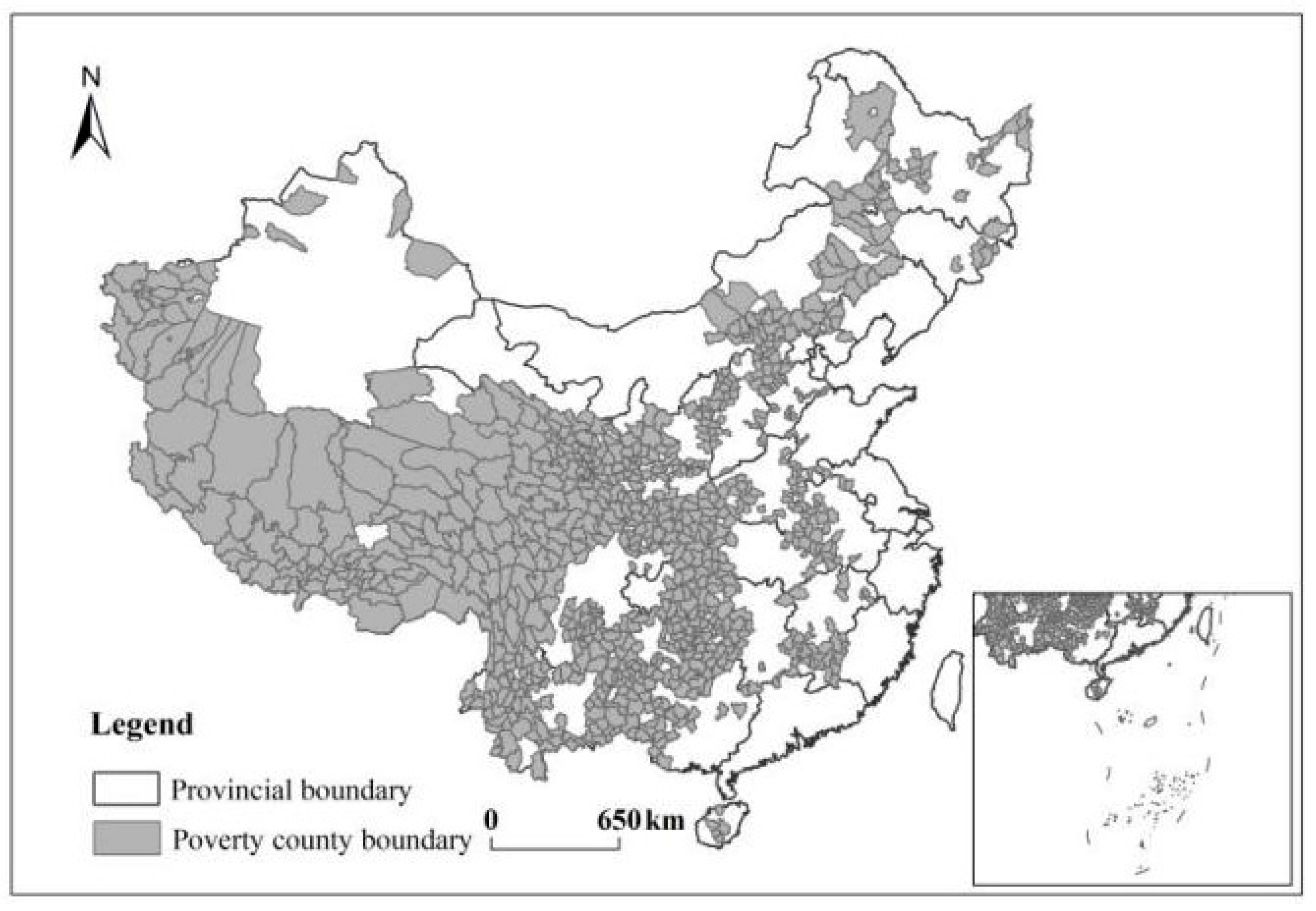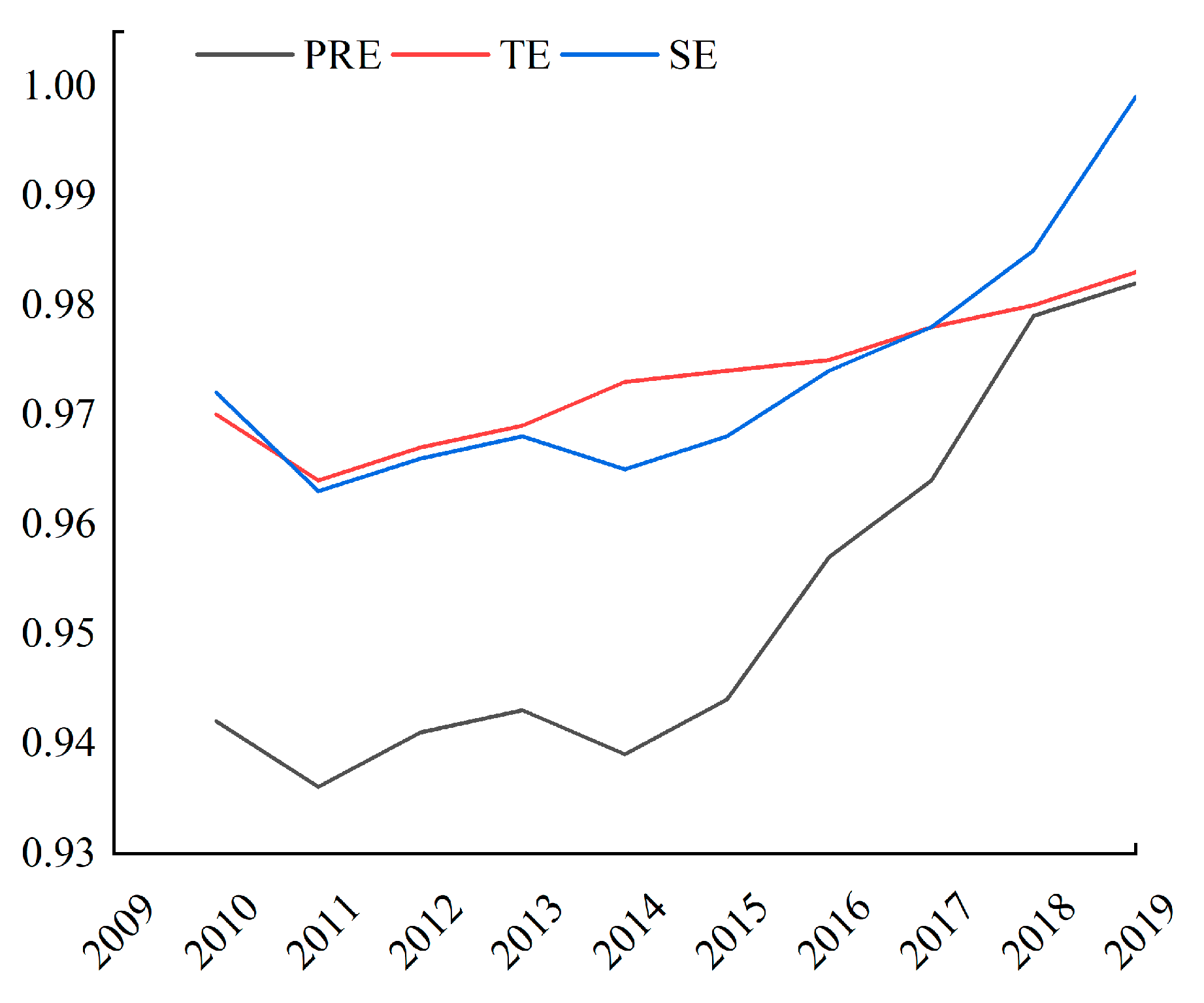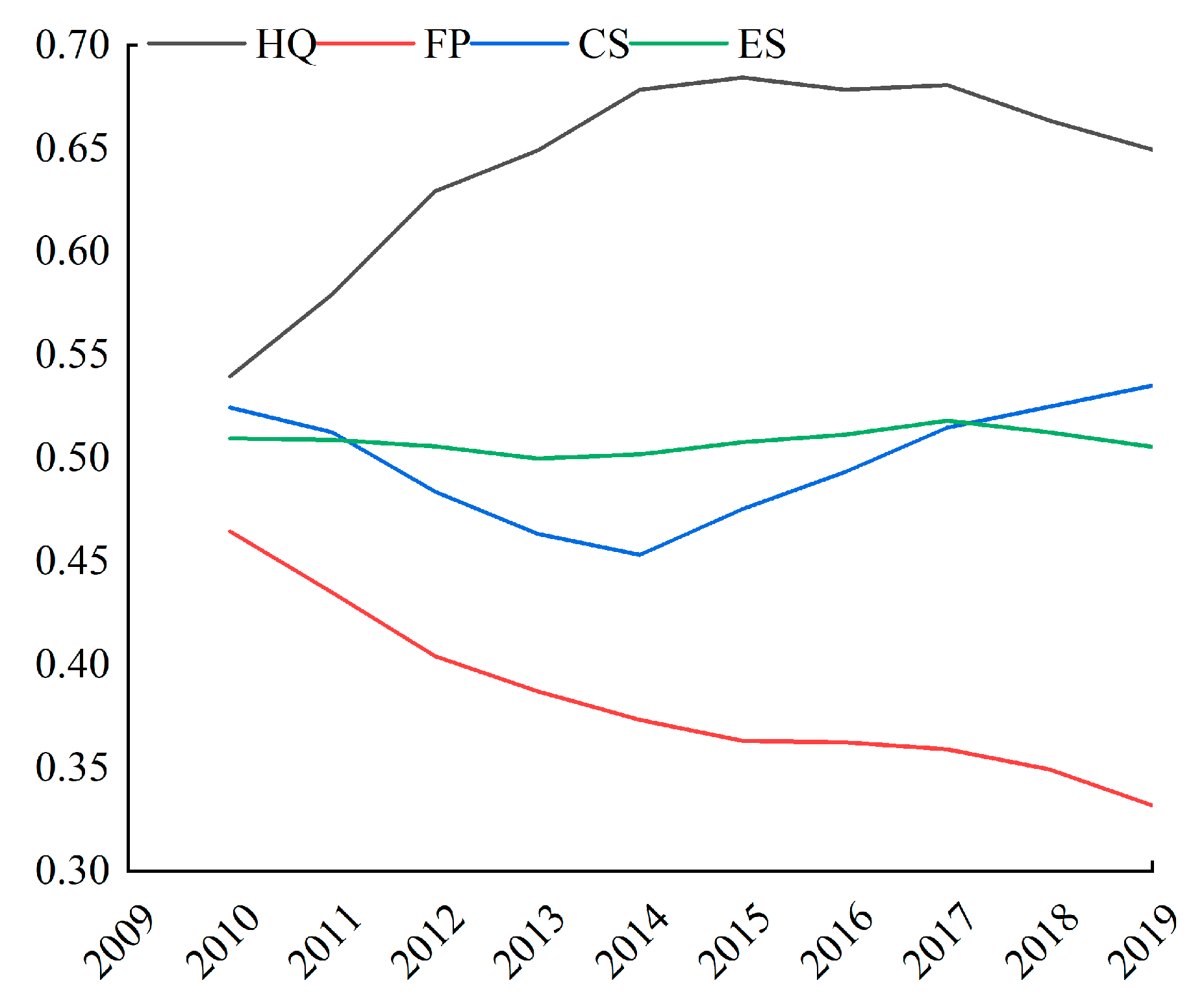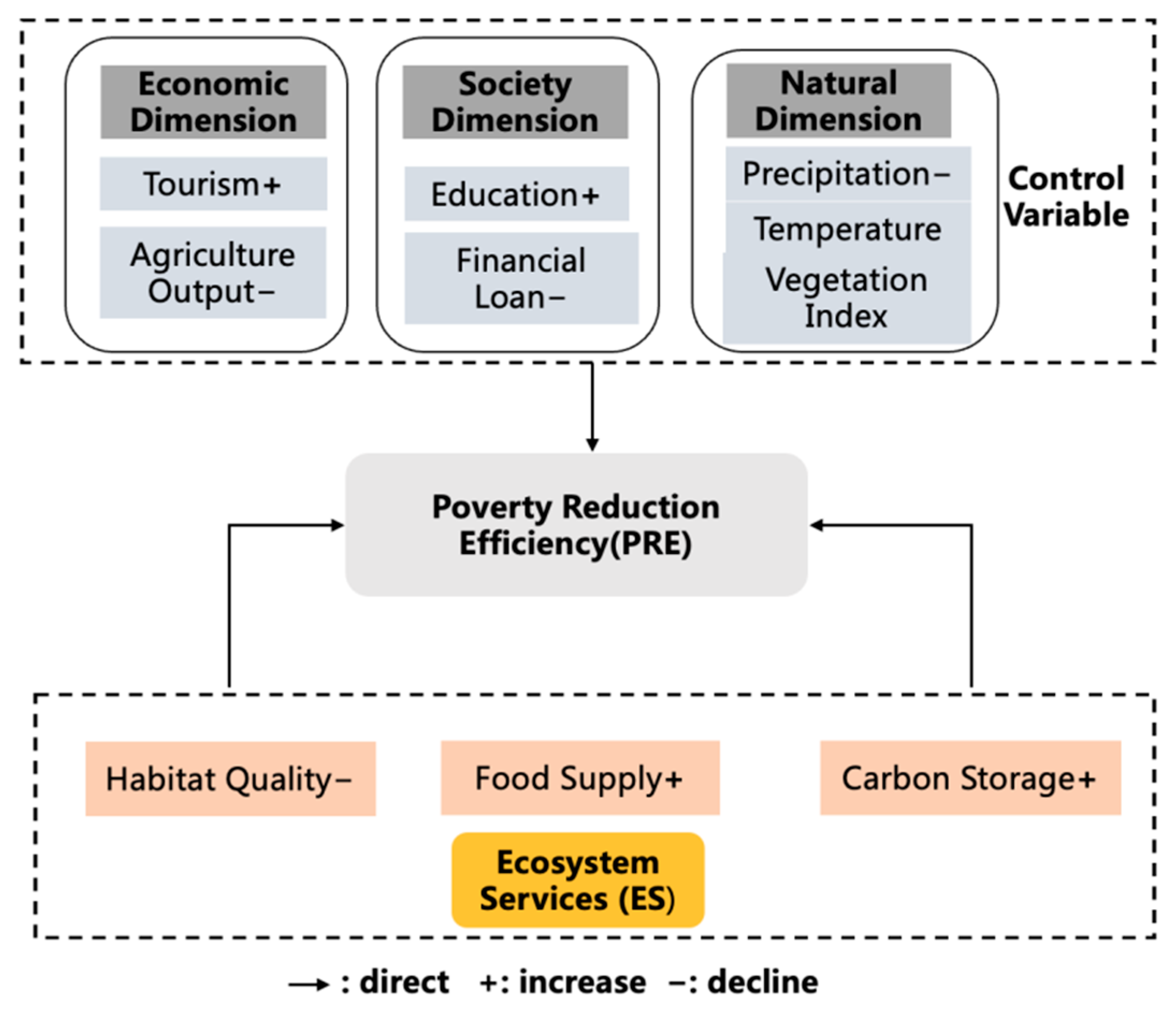How Do Ecosystem Services Affect Poverty Reduction Efficiency? A Panel Data Analysis of State Poverty Counties in China
Abstract
:1. Introduction
2. Literature Review
3. Study Area, Analytical Methods, and Data Sources
3.1. Study Area
3.2. Analytical Methods
3.2.1. Evaluation Model of Poverty Reduction Efficiency
- Data envelopment analysis model
- 2.
- Selection of input and output indicators
3.2.2. Evaluation Model of Ecosystem Service
- HQ
- 2.
- FP
- 3.
- CS
3.2.3. Analysis Model of the Impact of PRE on ES
3.3. Data Source
4. Empirical Results and Analysis
4.1. Analysis of PRE in Poverty Counties Based on DEA Method
4.2. Spatio-Temporal Analysis of ES in Poverty Counties
4.3. Spatio-Temporal Analysis of ES in Poverty Counties
4.3.1. Benchmark Regression Results
4.3.2. Robustness Analysis
4.3.3. Heterogeneity Analysis
- Different dimensions of ES
- 2.
- Different regions
5. Discussion
5.1. Analysis of the Mechanism of PRE Based on ES
5.2. Analysis of the Mechanism of PRE Based on ES
5.3. Research Limitations and Research Prospects
6. Conclusions
Author Contributions
Funding
Institutional Review Board Statement
Informed Consent Statement
Data Availability Statement
Conflicts of Interest
Appendix A
| Variables | Homogeneous Panel LLC | Homogeneous Panel LLC | Conclusion | ||
|---|---|---|---|---|---|
| T-Value | Significance | W-Value | Significance | ||
| PRE | −14.114 | 0.000 | −4.305 | 0.000 | stationary |
| TE | −11.898 | 0.000 | −4.017 | 0.000 | stationary |
| SE | −14.126 | 0.000 | −3.517 | 0.000 | stationary |
| ES | −8.518 | 0.000 | −5.785 | 0.000 | stationary |
| HQ | −7.134 | 0.000 | −4.003 | 0.000 | stationary |
| FP | −12.101 | 0.000 | −3.433 | 0.000 | stationary |
| CS | −4.715 | 0.000 | −4.621 | 0.000 | stationary |
| preci | −3.372 | 0.000 | −3.352 | 0.000 | stationary |
| temp | 0.265 | 0.000 | −4.533 | 0.000 | stationary |
| ndvi | −14.114 | 0.000 | −4.305 | 0.000 | stationary |
| agri | −11.898 | 0.000 | −4.017 | 0.000 | stationary |
| touism | −14.126 | 0.000 | −3.517 | 0.000 | stationary |
| edu | −8.518 | 0.000 | −5.785 | 0.000 | stationary |
| debt | −7.134 | 0.000 | −4.003 | 0.000 | stationary |
| Variables | Mean | Standard Deviation | Minimum | Maximum |
|---|---|---|---|---|
| PRE | 0.9220 | 0.1157 | 0.5630 | 1.4240 |
| TE | 1.0303 | 0.1222 | 0.6960 | 1.4020 |
| SE | 0.9060 | 0.1473 | 0.5850 | 1.2020 |
| ES | 0.5101 | 0.0976 | 0.0372 | 0.7172 |
| HQ | 0.6910 | 0.1596 | 0.0788 | 0.9806 |
| FP | 0.3632 | 0.2739 | 0 | 1 |
| CS | 0.4243 | 0.1378 | 0 | 1 |
| preci | 8.9753 | 0.6027 | 5.5114 | 10.2416 |
| temp | 4.4286 | 0.9884 | −4.1412 | 5.5489 |
| ndvi | 0.7093 | 0.1873 | 0.0521 | 0.8950 |
| agri | 11.9613 | 1.5203 | 7.6059 | 13.0878 |
| touism | 5.1462 | 1.9437 | 0.8963 | 13.2631 |
| edu | 11.3502 | 1.9221 | 4.1146 | 18.3481 |
| debt | 13.1973 | 1.1126 | 10.2601 | 16.3805 |
| Variables | PRE | ES | preci | temp | ndvi | agri | tourism | edu | debt |
|---|---|---|---|---|---|---|---|---|---|
| PRE | 1 | ||||||||
| ES | 0.2010 *** | 1 | |||||||
| preci | 0.0909 *** | 0.1205 *** | 1 | ||||||
| temp | 0.1160 *** | 0.2822 *** | 0.1581 *** | 1 | |||||
| ndvi | 0.1640 *** | 0.2530 *** | 0.2825 *** | 0.1037 *** | 1 | ||||
| agri | 0.0456 *** | 0.1166 *** | 0.0375 ** | 0.0830 *** | 0.0969 *** | 1 | |||
| touism | 0.0580 *** | 0.0267 * | −0.0437 * | 0.1168 ** | 0.0526 *** | 0.0114 * | 1 | ||
| edu | −0.0568 ** | 0.2924 *** | 0.042 *** | 0.1434 *** | 0.2370 *** | 0.0630 *** | 0.0635 *** | 1 | |
| debt | −0.1759 *** | 0.0207 * | −0.0211 * | −0.0582 *** | 0.0246 * | 0.1691 *** | 0.0467 *** | 0.0347 *** | 1 |
References
- Liu, Y.; Wang, Y. Rural land engineering and poverty alleviation: Lessons from typical regions in China. J. Geogr. Sci. 2019, 29, 643–657. [Google Scholar] [CrossRef] [Green Version]
- Wan, G.; Hu, X.; Liu, W. China’s poverty reduction miracle and relative poverty: Focusing on the roles of growth and inequality. China Econ. Rev. 2021, 68, 16–43. [Google Scholar] [CrossRef]
- Shuai, J.; Liu, J.; Cheng, J.; Cheng, X. Interaction between ecosystem services and rural poverty reduction: Evidence from China. Environ. Sci. Policy 2021, 119, 1–11. [Google Scholar] [CrossRef]
- Wang, H.; Wen, T.; Han, J. Can Rural Households, Loan Effectively Improve the Quality of Poverty Alleviation in Areas of Extreme Poverty? Chin. Rural. Econ. 2020, 18, 55–68. (In Chinese) [Google Scholar]
- Kieslich, M.; Salles, J. Implementation context and science-policy interfaces: Implications for the economic valuation of ecosystem services. Ecol. Econom. 2021, 179, 1–12. [Google Scholar] [CrossRef]
- Fisher, J.A.; Patenaude, G.; Giri, K.; Lewis, K.; Meir, P.; Pinho, P.; Rounsevell, M.D.A.; Williams, M. Understanding the relationships between ecosystem services and poverty alleviation: A conceptual framework. Ecosyst. Serv. 2014, 7, 34–45. [Google Scholar] [CrossRef] [Green Version]
- Chen, Y.; Xia, Q.; Wang, X. Consumption and Income Poverty in Rural China: 1995–2018. China World Econ. 2021, 29, 63–88. (In Chinese) [Google Scholar] [CrossRef]
- Alkire, S.; Foster, J. Counting and multidimensional poverty measurement. J. Public Econ. 2011, 95, 476–487. [Google Scholar] [CrossRef] [Green Version]
- Gallardo, M. Using the downside mean-semideviation for measuring vulnerability to poverty. Econ. Lett. 2013, 120, 416–428. [Google Scholar] [CrossRef]
- Si, L.; Wang, C. Measurement of Regional Poverty Alleviation Quality and its Spatiotemporal Evolution: A Study Based on Night Light Data of Poor Counties. J. Macro-Qual. Res. 2020, 31, 1–14. (In Chinese) [Google Scholar]
- Wang, Z.; Li, J.; Liu, J.; Shuai, C. Is the photovoltaic poverty alleviation project the best way for the poor to escape poverty?—A DEA and GRA Analysis of Different Projects in Rural China. Energy Policy 2020, 137, 1105–1111. [Google Scholar] [CrossRef]
- Gu, N.; Liu, Y. Does Industrial Poverty Alleviation Reduce Poverty Vulnerability of Poor Households? J. Agrotech. Econ. 2021, 7, 92–102. (In Chinese) [Google Scholar]
- Abosedra, S.; Shahbaz, M.; Nawaz, K. Modeling Causality between Financial Deepening and Poverty Reduction in Egypt. Soc. Indic. Res. 2015, 126, 955–969. [Google Scholar] [CrossRef]
- Zhao, L. Tourism, Institutions, and Poverty Alleviation: Empirical Evidence from China. J. Travel. Res. 2020, 28, 467–487. [Google Scholar] [CrossRef]
- Xie, Y.; Xie, E. Comparing Income Poverty with Multidimensional Well-being Based on the “Conversion Efficiency”. Soc. Indic. Res. 2020, 154, 61–77. [Google Scholar] [CrossRef]
- Baloch, M.A.B.; Danish; Khan, S.U.-D.K.; Ulucak, Z.Ş.; Ahmad, A. Analyzing the relationship between poverty, income inequality, and CO2 emission in Sub-Saharan African countries. Sci. Total Environ. 2020, 740, 986–997. [Google Scholar] [CrossRef] [PubMed]
- Jiang, A.; Chen, C.; Ao, Y.; Zhou, W. Measuring the Inclusive growth of rural areas in China. Appl. Econ. 2021, 2, 1–14. [Google Scholar] [CrossRef]
- Tavares, F.F.; Betti, G. The Pandemic of Poverty, Vulnerability, and COVID-19: Evidence from a Fuzzy Multidimensional Analysis of Deprivations in Brazil. World Dev. 2021, 139, 35–48. [Google Scholar] [CrossRef]
- Yao, Y.; Sun, J.; Tian, Y.; Zheng, C.; Liu, J. Alleviating water scarcity and poverty in drylands through telecouplings: Vegetable trade and tourism in northwest China. Sci. Total Environ. 2020, 741, 1403–1487. [Google Scholar] [CrossRef]
- Koomson, I.; Danquah, M. Financial inclusion and energy poverty: Empirical evidence from Ghana. Energy Econ. 2021, 94, 1–12. [Google Scholar] [CrossRef]
- Wang, F.; Zhen, H.; Zhang, W.; Wang, H.; Peng, W.-J. Regional differences and their driving mechanism of relationships between rural household livelihood and ecosystem services: A case study in upstream watershed of Miyun Reservoir, China. J. Appl. Ecol. 2021, 18, 1–13. (In Chinese) [Google Scholar]
- Zhao, S.; Wu, X.; Zhou, J.; Pereira, P. Spatiotemporal tradeoffs and synergies in vegetation vitality and poverty transition in rocky desertification area. Sci. Total Environ. 2021, 752, 1417–1470. [Google Scholar] [CrossRef] [PubMed]
- Caldés, N.; Coady, D.; Maluccio, J.A. The Cost of Poverty Alleviation Transfer Programs: A Comparative Analysis of Three Programs in Latin America. World Dev. 2006, 34, 818–837. [Google Scholar] [CrossRef] [Green Version]
- Li, M. Decomposing the change of CO2 emissions in China: A distance function approach. Ecol. Econom. 2010, 70, 77–85. [Google Scholar] [CrossRef]
- Meng, S.; Zhou, W.; Chen, J.; Zhang, C. A synthesized data envelopment analysis model and its application in resource efficiency evaluation and dynamic trend analysis. Energy Environ. 2018, 29, 260–280. [Google Scholar] [CrossRef]
- Ouyang, X.; Tang, L.; Wei, X.; Li, Y. Spatial interaction between urbanization and ecosystem services in Chinese urban agglomerations. Land Use Policy 2021, 109, 1055–1087. [Google Scholar] [CrossRef]
- Di Febbraro, M.; Sallustio, L.; Vizzarri, M.; De Rosa, D.; De Lisio, L.; Loy, A.; Eichelberger, B.A.; Marchetti, M. Expert-based and correlative models to map habitat quality: Which gives better support to conservation planning? Glob. Ecol. Conserv. 2018, 16, e00513. [Google Scholar] [CrossRef]
- Zhang, D.; Huang, Q.; He, C.; Wu, J. Impacts of urban expansion on ecosystem services in the Beijing-Tianjin-Hebei urban agglomeration, China: A scenario analysis based on the Shared Socioeconomic Pathways. Resour. Conserv. Recycl. 2017, 125, 115–130. [Google Scholar] [CrossRef]
- Sharp, R.; Tallis, H.T.; Ricketts, T.; Guerry, A.D.; Wood, S.A.; ChaplinKramer, R.; Nelson, E.; Ennaanay, E.; Wolny, S.; Olwero, N. InVEST User’s Guide; The Natural Capital Project: Stanford, CA, USA, 2014. [Google Scholar]
- Peng, B.; Yu, J.; Zhu, Y. A heteroskedasticity robust test for cross-sectional correlation in a fixed effects panel data model. Econ. Lett. 2021, 201, 1097–1099. [Google Scholar] [CrossRef]
- Majeed, A.; Wang, L.; Zhang, X.; Kirikkaleli, D. Modeling the dynamic links among natural resources, economic globalization, disaggregated energy consumption, and environmental quality: Fresh evidence from GCC economies. Resour. Policy 2021, 73, 1022–1040. [Google Scholar] [CrossRef]
- Li, Y.; Zhang, Q.; Wang, G.; Liu, X.; Mclellan, B. Promotion policies for third party financing in Photovoltaic Poverty Alleviation projects considering social reputation. J. Clean. Prod. 2019, 211, 350–359. [Google Scholar] [CrossRef]
- Cheng, X.; Chen, J.; Jiang, S.; Dai, Y.; Shuai, C.; Li, W.; Liu, Y.; Wang, C.; Zhou, M.; Zou, L.; et al. The impact of rural land consolidation on household poverty alleviation: The moderating effects of human capital endowment. Land Use Policy 2021, 109, 1056–1092. [Google Scholar] [CrossRef]
- Pan, Y.; Wu, J.; Zhang, Y.; Zhang, X.; Yu, C. Simultaneous enhancement of ecosystem services and poverty reduction through adjustments to subsidy policies relating to grassland use in Tibet. China. Ecosyst. Serv. 2021, 48, 1–8. [Google Scholar] [CrossRef]
- Haider, L.J.; Boonstra, W.J.; Peterson, G.D.; Schlüter, M. Traps and Sustainable Development in Rural Areas: A Review. World. Dev. 2018, 101, 311–321. [Google Scholar] [CrossRef] [Green Version]
- Suich, H.; Howe, C.; Mace, G. Ecosystem services and poverty alleviation: A review of the empirical links. Ecosyst. Serv. 2015, 12, 137–147. [Google Scholar] [CrossRef] [Green Version]
- Bathla, S.; Joshi, P.K.; Kumar, A. Targeting Agricultural Investments and Input Subsidies in Low-Income Lagging Regions of India. Eur. J. Dev. Res. 2019, 31, 1197–1226. [Google Scholar] [CrossRef]
- Liu, F.; Li, L.; Zhang, Y.; Ngo, Q.T.; Iqbal, W. Role of education in poverty reduction: Macroeconomic and social determinants form developing economies. Environ. Sci. Pollut. Res. 2021, 28, 63163–63177. [Google Scholar] [CrossRef] [PubMed]
- Nizam, R.; Karim, Z.A.; Rahman, A.A.; Sarmidi, T. Financial inclusiveness and economic growth: New evidence using a threshold regression analysis. Econ. Res. Ekon. Istraživanja 2020, 33, 1465–1484. [Google Scholar] [CrossRef]
- Neaime, S.; Gaysset, I. Financial inclusion and stability in MENA: Evidence from poverty and inequality. Financ. Res. Lett. 2018, 24, 230–237. [Google Scholar] [CrossRef]
- Liu, M.; Feng, X.; Wang, S. Does poverty-alleviation-based industry development improve farmers’ livelihood capital? J. Integr. Agric. 2021, 20, 915–926. [Google Scholar] [CrossRef]






| Indicators | Indicator Symbol | Explanation | |
|---|---|---|---|
| Input indicators | financial fund investment | financial | per capita expenditure of fiscal funds (yuan/person) |
| the amount of employment | employment | the amount of employment in the secondary and tertiary industries (10,000 per person) | |
| construction land | urbanland | area of regional construction land (m2) | |
| research and development expenditure | rd | internal expenditure for research and experimental development (CNY 10,000) | |
| Output indicators | net income per capita | perincome | per capita net income of the region (yuan/person) |
| non-poverty incidence | poverty | single-poverty incidence |
| Variable Type | Variable Symbol | Explanation |
|---|---|---|
| Comprehensive efficiency of poverty reduction | PRE | calculated from Section 3.2.1 of this paper |
| Technical efficiency | TE | |
| Scale efficiency | SE | |
| Ecosystem services | ES | calculated from Section 3.2.2 of this paper |
| Habitat quality | HQ | |
| Food production | FP | |
| Carbon storage | CS | |
| Precipitation | preci | regional annual rainfall (mm) |
| Temperature | temp | regional annual average temperature (degrees Celsius) |
| Vegetation index | ndvi | regional vegetation index |
| Agricultural output value | agri | regional agricultural output value (CNY 10,000) |
| Tourism income | tourism | regional tourism revenue (CNY 100,000,000) |
| Education expenditure | edu | regional education expenditure (CNY 10,000) |
| Financial loans | debt | regional financial loan line (CNY 10,000) |
| PRE | TE | SE | ||||
|---|---|---|---|---|---|---|
| (1) | (2) | (3) | (4) | (5) | (6) | |
| ES | 0.238 *** | 0.274 *** | 0.055 ** | 0.063 ** | 0.205 *** | 0.247 *** |
| (10.231) | (12.752) | (2.183) | (3.552) | (6.850) | (9.719) | |
| tourism | 0.004 *** | 0.012 *** | −0.005 *** | |||
| (3.259) | (9.884) | (−3.915) | ||||
| edu | 0.009 *** | 0.006 *** | 0.013 *** | |||
| (7.085) | (4.602) | (9.043) | ||||
| debt | −0.026 *** | 0.031 *** | −0.055 *** | |||
| (−11.431) | (13.124) | (−20.026) | ||||
| preci | −0.020 *** | −0.004 | −0.017 *** | |||
| (−3.765) | (−0.726) | (−2.690) | ||||
| temp | 0.003 | −0.016 *** | 0.016 *** | |||
| (1.127) | (−5.786) | (4.946) | ||||
| ndvi | 0.009 | 0.141 *** | −0.108 *** | |||
| (0.384) | (5.534) | (−3.661) | ||||
| agri | −0.011 *** | −0.009 *** | 0.020 *** | |||
| (−6.423) | (−5.106) | (9.905) | ||||
| cons | 0.801 *** | 1.210 *** | 1.002 *** | 0.666 *** | 0.801 *** | 1.512 *** |
| (66.208) | (23.677) | (76.938) | (12.486) | (51.460) | (24.471) | |
| Year and region effect | control | control | control | control | control | control |
| N | 2487 | 2478 | 2487 | 2478 | 2487 | 2478 |
| PRE_dum | TE_dum | SE_dum | |
|---|---|---|---|
| (1) | (2) | (3) | |
| ES | 0.919 *** | 1.053 *** | 1.292 *** |
| (4.605) | (5.639) | (6.466) | |
| tourism | 0.011 *** | 0.013 *** | 0.001 |
| (2.687) | (2.585) | (0.285) | |
| edu | 0.001 | 0.040 *** | 0.039 *** |
| (0.274) | (8.014) | (8.881) | |
| debt | −0.013 * | 0.156 *** | −0.151 *** |
| (−1.667) | (13.736) | (−12.472) | |
| preci | −0.041 ** | −0.046 ** | −0.068 *** |
| (−2.056) | (−2.055) | (−3.227) | |
| temp | 0.010 | −0.063 *** | 0.031 ** |
| (0.835) | (−4.663) | (2.440) | |
| ndvi | 0.240 ** | 0.504 *** | −0.038 |
| (2.433) | (4.815) | (−0.368) | |
| agri | −0.002 | −0.056 *** | 0.049 *** |
| (−0.326) | (−7.289) | (6.726) | |
| Year and region effect | control | control | control |
| N | 2478 | 2478 | 2478 |
| Explained Variable: PRE | |||
|---|---|---|---|
| (1) | (2) | (3) | |
| HQ | −0.128 *** | ||
| (−7.009) | |||
| FP | 0.111 *** | ||
| (12.842) | |||
| CS | 0.092 *** | ||
| (5.574) | |||
| cons | 1.179 *** | 1.170 *** | 1.218 *** |
| (22.924) | (23.065) | (23.600) | |
| Control variable | control | control | control |
| Year and region effect | control | control | control |
| N | 2478 | 2478 | 2478 |
| Explained Variable: PRE | |||
|---|---|---|---|
| Eastern Region | Central Region | Western Region | |
| (1) | (2) | (3) | |
| ES | 0.4527 ** | 0.3635 *** | 0.2342 *** |
| (2.36) | (3.49) | (5.05) | |
| cons | 1.5758 *** | 0.8697 *** | 1.3078 *** |
| (4.95) | (7.34) | (22.54) | |
| Control variable | control | control | control |
| Year and region effect | control | control | control |
| N | 150 | 633 | 1695 |
Publisher’s Note: MDPI stays neutral with regard to jurisdictional claims in published maps and institutional affiliations. |
© 2022 by the authors. Licensee MDPI, Basel, Switzerland. This article is an open access article distributed under the terms and conditions of the Creative Commons Attribution (CC BY) license (https://creativecommons.org/licenses/by/4.0/).
Share and Cite
Cao, P.; Ouyang, X.; Xu, J. How Do Ecosystem Services Affect Poverty Reduction Efficiency? A Panel Data Analysis of State Poverty Counties in China. Int. J. Environ. Res. Public Health 2022, 19, 1886. https://doi.org/10.3390/ijerph19031886
Cao P, Ouyang X, Xu J. How Do Ecosystem Services Affect Poverty Reduction Efficiency? A Panel Data Analysis of State Poverty Counties in China. International Journal of Environmental Research and Public Health. 2022; 19(3):1886. https://doi.org/10.3390/ijerph19031886
Chicago/Turabian StyleCao, Peng, Xiao Ouyang, and Jun Xu. 2022. "How Do Ecosystem Services Affect Poverty Reduction Efficiency? A Panel Data Analysis of State Poverty Counties in China" International Journal of Environmental Research and Public Health 19, no. 3: 1886. https://doi.org/10.3390/ijerph19031886
APA StyleCao, P., Ouyang, X., & Xu, J. (2022). How Do Ecosystem Services Affect Poverty Reduction Efficiency? A Panel Data Analysis of State Poverty Counties in China. International Journal of Environmental Research and Public Health, 19(3), 1886. https://doi.org/10.3390/ijerph19031886







